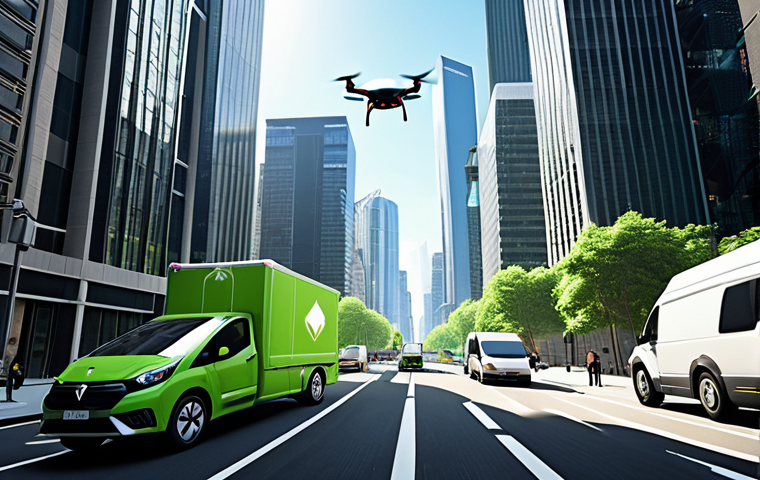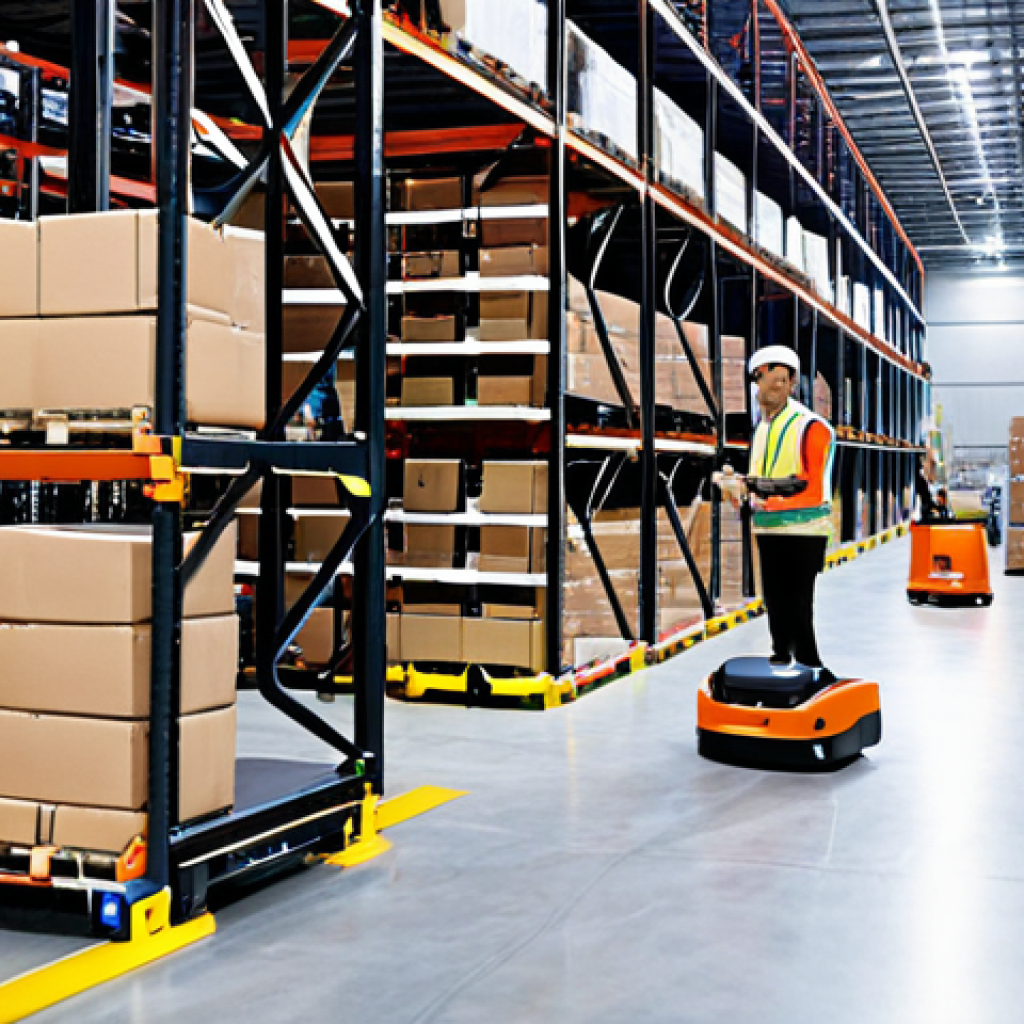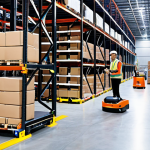The world of logistics is changing faster than ever. I remember when warehouse management meant endless rows of shelves and countless hours spent manually tracking inventory.
These days, however, automation is not just a luxury, but a necessity for staying competitive. From self-driving forklifts to AI-powered warehouse management systems, the future of logistics is undoubtedly automated and will lead to higher efficiency.
It’s really incredible to see how quickly technology is changing this industry, and honestly, it’s making things much smoother for everyone involved. Let’s delve into the details in the article below.
Embracing Robotics: The New Workforce in Logistics

Enhanced Efficiency with Automated Guided Vehicles (AGVs)
Okay, so I’ve been on a few warehouse tours lately, and let me tell you, the rise of AGVs is mind-blowing. Imagine forklifts that navigate themselves using sophisticated sensors and pre-programmed routes. It’s not just about reducing labor costs; it’s about optimizing every square inch of the warehouse. I saw one facility where AGVs were moving pallets 24/7, with only minimal human oversight. The increase in throughput was astounding, and the reduction in accidents was a huge win. Think about it – no more human error in the most repetitive, and dangerous tasks.
The Role of Collaborative Robots (Cobots)
Then there are cobots, those friendly looking robots designed to work alongside humans. I recently talked to a warehouse worker who was initially worried about being replaced by robots. But after working with a cobot for a few weeks, he realized it was more like having a super-efficient teammate. The cobot handled the heavy lifting and repetitive tasks, freeing him up to focus on more complex problem-solving and quality control. It’s all about teamwork, and honestly, it’s making the job way less physically demanding.
AI-Powered Warehouse Management Systems: The Brains of the Operation
Predictive Analytics for Demand Forecasting
I’ve been digging into how AI is revolutionizing warehouse management, and the predictive analytics aspect is really interesting. Imagine being able to anticipate spikes in demand with near-perfect accuracy. That’s what AI-powered systems are doing. They analyze historical data, market trends, and even social media buzz to forecast demand, allowing warehouses to optimize inventory levels and staffing. I spoke with a supply chain manager who said this has drastically reduced stockouts and overstocking, saving his company a ton of money.
Real-Time Inventory Tracking with Machine Learning
Remember the days of manually scanning barcodes and hoping the data was accurate? Those days are fading fast. Machine learning algorithms are now used to track inventory in real-time, using cameras, sensors, and RFID tags. I visited a distribution center where every item was tracked from the moment it entered the warehouse until it was shipped out. The system could even detect misplaced items and alert workers, minimizing losses and improving order accuracy. It’s like having a super-efficient, never-sleeping inventory auditor.
The Rise of Automated Sorting and Packing Systems
High-Speed Conveyor Systems
I’ve seen some incredible conveyor systems lately that can sort and route packages at mind-boggling speeds. These systems use a combination of barcode scanners, cameras, and robotic arms to identify and direct packages to the correct loading dock. It’s like watching a complex, perfectly choreographed dance. I talked to an operations manager who said that these systems have not only increased throughput but also reduced the number of damaged packages, thanks to the gentle handling of the automated arms.
Robotic Pick and Place
Then there’s the rise of robotic pick and place systems, which are perfect for e-commerce fulfillment. These robots can identify and pick items from bins or shelves and place them into boxes for shipping, all without human intervention. I watched one robot picking and packing orders with incredible speed and precision. It was fascinating to see how these robots could adapt to different item shapes and sizes, making them incredibly versatile. This is definitely the future of e-commerce fulfillment.
Drones in Logistics: Taking to the Skies
Warehouse Inventory Management with Drones
I recently read about a company using drones to scan barcodes on high shelves in their warehouse. It’s seriously cool. Think about it – no more needing those cherry pickers or having workers climb up to dangerous heights. The drones can zip around, capturing data in minutes that would take hours with traditional methods. The data is then fed into the inventory management system, providing real-time updates and improving accuracy. It’s all about making those repetitive tasks safer and faster.
Last-Mile Delivery Solutions
Now, let’s talk about last-mile delivery. I saw a demonstration of drones delivering packages to customers’ doorsteps, and I was completely blown away. Imagine ordering something online and having it arrive within minutes, flown directly to you by a drone. It’s not just a futuristic fantasy; it’s becoming a reality. While there are still regulatory hurdles to overcome, the potential for faster and more efficient delivery is undeniable. Plus, think about the reduced traffic congestion and lower emissions – it’s a win-win.
Data-Driven Decision Making: The Power of Logistics Analytics
Real-Time Performance Monitoring
I’ve been spending a lot of time looking at logistics analytics, and it’s incredible how much data is being generated and analyzed in real-time. Imagine having a dashboard that shows you exactly what’s happening in your warehouse, from inventory levels to employee performance. This allows managers to identify bottlenecks, optimize workflows, and make data-driven decisions. I spoke with a CEO who said that implementing a real-time performance monitoring system has completely transformed his company’s operations, leading to significant cost savings and improved customer satisfaction.
Predictive Maintenance for Equipment
Another area where data analytics is making a big impact is in predictive maintenance. By analyzing sensor data from equipment like forklifts and conveyor belts, companies can predict when maintenance is needed, preventing breakdowns and minimizing downtime. I learned about a company that was able to reduce its maintenance costs by 30% by implementing a predictive maintenance program. It’s all about using data to keep things running smoothly and avoid costly surprises.
Challenges and Opportunities in Logistics Automation
Initial Investment Costs
Alright, let’s be real – logistics automation isn’t cheap. The initial investment in robots, AI systems, and other technologies can be significant. I’ve talked to a few smaller companies that were hesitant to invest because of the upfront costs. However, they also realized that the long-term benefits, such as increased efficiency, reduced labor costs, and improved customer satisfaction, often outweigh the initial investment. It’s about taking a long-term view and understanding the return on investment.
Workforce Transition and Training
Another challenge is the need to retrain and upskill the workforce. As automation becomes more prevalent, some jobs may be eliminated, but new jobs will also be created. I believe it’s important for companies to invest in training programs to help workers adapt to the changing job market. I saw one company that was partnering with local community colleges to offer training in robotics and AI. It’s all about preparing the workforce for the future and ensuring that everyone has the opportunity to succeed in the automated world.
Sustainability in Automated Logistics: Going Green
Optimized Routing for Reduced Emissions
I’m really excited about how automation can contribute to sustainability in logistics. For example, AI-powered routing systems can optimize delivery routes to minimize fuel consumption and reduce emissions. I read about a study that showed that optimized routing can reduce fuel consumption by up to 20%. That’s a huge win for the environment and for the company’s bottom line.
Electric Vehicles and Charging Infrastructure
The rise of electric vehicles is also playing a big role in sustainable logistics. Electric forklifts, delivery trucks, and even drones are becoming more common, reducing reliance on fossil fuels and minimizing air pollution. I saw a warehouse that had installed a network of charging stations for its electric forklifts. It’s all about embracing new technologies to create a more sustainable future for logistics.
Examples of Automation Technologies in Logistics
| Technology | Description | Benefits |
|---|---|---|
| Automated Guided Vehicles (AGVs) | Self-driving vehicles that transport materials within a warehouse. | Increased efficiency, reduced labor costs, improved safety. |
| Collaborative Robots (Cobots) | Robots that work alongside humans to perform tasks. | Enhanced productivity, reduced physical strain on workers. |
| AI-Powered Warehouse Management Systems | Software that uses AI to optimize inventory management and demand forecasting. | Improved inventory accuracy, reduced stockouts, better demand planning. |
| Automated Sorting Systems | High-speed conveyor systems that sort and route packages. | Increased throughput, reduced handling errors. |
| Drones | Unmanned aerial vehicles used for inventory management and last-mile delivery. | Faster inventory counts, quicker deliveries, reduced traffic congestion. |
Wrapping Up
As we’ve explored, the integration of automation into logistics is not just a futuristic fantasy but a rapidly evolving reality. From AGVs navigating warehouse floors to drones delivering packages, the potential benefits are enormous. Embracing these changes will be crucial for staying competitive and building a more efficient, sustainable, and resilient supply chain. It’s an exciting time to be in logistics, with endless opportunities for innovation and growth.
Good to Know
1. Stay Updated on Industry Trends: Keep an eye on the latest developments in logistics automation through industry publications, conferences, and webinars.
2. Assess Your Current Operations: Evaluate your current logistics processes to identify areas where automation can have the most significant impact.
3. Start Small and Scale Gradually: Consider starting with a pilot project to test the waters before making a large-scale investment in automation technologies.
4. Invest in Employee Training: Provide training and upskilling opportunities for your employees to help them adapt to the changing job roles in an automated environment.
5. Focus on Data Security: Implement robust data security measures to protect your company’s sensitive information from cyber threats.
Key Takeaways
Automation is transforming logistics, offering significant benefits in terms of efficiency, cost savings, and sustainability. While there are challenges to overcome, such as initial investment costs and workforce transition, the long-term rewards are substantial. Companies that embrace automation and invest in their workforce will be best positioned to thrive in the future of logistics.
Frequently Asked Questions (FAQ) 📖
Q: What are some examples of automation in warehouse management mentioned in the introduction?
A: The introduction highlights self-driving forklifts and AI-powered warehouse management systems as examples of automation that are changing logistics.
Q: Why is automation considered a necessity in the current logistics landscape?
A: Automation is no longer a luxury but a necessity because it helps businesses stay competitive by improving efficiency and making operations smoother for everyone involved.
Q: What is the author’s overall sentiment towards the increasing automation in the logistics industry?
A: The author expresses a positive sentiment, finding it “really incredible” to see how quickly technology is changing the industry and indicating that it is making things much smoother.
📚 References
Wikipedia Encyclopedia
구글 검색 결과
구글 검색 결과
구글 검색 결과
구글 검색 결과
구글 검색 결과





